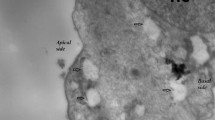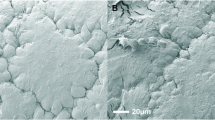Abstract
Purpose
To demonstrate the morphological and physiological characteristics of lens epithelial cells (LECs) in patients with traumatic cataract using transmission electron microscopy (TEM) to further understand penetrating ocular injury-induced cataract morphology and epithelial repair mechanisms involved at a cellular level.
Methods
This is a prospective international study. Sixteen eyes of 16 consecutive patients who were diagnosed as traumatic white cataracts following the anterior lens capsule perforation and 13 eyes of 13 patients with idiopathic posterior subcapsular cataract were included to the study. The anterior lens capsules (aLCs: basement membrane and associated LECs) were obtained from cataract surgery and prepared for TEM.
Results
Two prominent cell types were observed in all aLCs of the traumatic cases: degenerated type LECs having variable sized intraepithelial vacuoles close to injury site and normal appearing LECs having an euchromatic nucleus distant from the injury site. In control group, the LECs and all their elements were in normal ultrastructural pattern except some small intraepithelial vacuoles, which were fewer and smaller than the vacuoles in the degenerated LECs of the traumatic group.
Conclusions
The ultrastructural findings of our cases support that traumatically induced dysfunction of the lens epithelium may lead to an edema in superficial cortical lens fibers that subsequently undergo degeneration and produce a localized zone of vacuolization.




Similar content being viewed by others
References
Tasman W, Jaegar EA (1997) Traumatic cataract. Duane’s. Clin Ophthalmol 1:13–14
Khatry SK, Lewis AE, Schein OD, Thapa MD, Pradhan EK, Katz J (2004) The epidemiology of ocular trauma in rural Nepal. Br J Ophthalmol 88:456–460
Tsurimaki Y (1993) Traumatic cataract. Current encyclopedia of ophthalmology. Tokyo, Nakayama-Shoten, pp 175–180
Shah MA, Shah SM, Shah SB, Patel CG, Patel UA (2011) Morphology of traumatic cataract: does it play a role in final visual outcome? BMJ Open 1:60
Meyer LM, Wegener AR, Holz FG, Kronschläger M, Bergmanson JP, Soderberg PG (2014) Ultrastructure of UVR-B-induced cataract and repair visualized with electron microscopy. Acta Ophthalmol 92:635–643
Font RL, Brownstein S (1974) A light and electron microscopic study of anterior subcapsular cataracts. Am J Ophthalmol 78:972–984
Tekin K, Erol YO, Inanc M, Sargon MF, Can CU, Polat S, Yilmazbas P (2017) Electron microscopic evaluation of anterior lens epithelium in patients with idiopathic congenital cataract. Int Ophthalmol. https://doi.org/10.1007/s10792-017-0713-1 [Epub ahead of print]
Straatsma BR, Lightfoot DO, Barke RM, Horwitz J (1991) Lens capsule and epithelium in age-related cataract. Am J Ophthalmol 112:283–296
Giblin FJ, Chakrapani B, Reddy VN (1976) Glutathione and lens epithelial function. Invest Ophthalmol 155:381–393
Bhat SP (2001) The ocular lens epithelium. Biosci Rep 21:537–563
Michael R, Bron AJ (2011) The ageing lens and cataract: a model of normal and pathological ageing. Philos Trans R Soc Lond B Biol Sci 366:1278–1292
Rafferty NS, Goosens W, March WF (1974) Ultrastructure of human traumatic cataract. Am J Ophthalmol 78:985–995
Fagerholm PP, Lundevall E, Trocmé S, Wroblewski R (1986) Human and experimental lens repair and calcification. Exp Eye Res 43:965–972
Fagerholm PP, Philipson BT (1979) Experimental traumatic cataract. I. A quantitative microradiographic study. Invest Ophthalmol Vis Sci 18:1151–1159
Fagerholm PP, Philipson BT (1979) Experimental traumatic cataract. II. A transmission electron microscopy and extracellular tracer study. Invest Ophthalmol Vis Sci 18:1160–1171
Wakasugi A, Uga S, Sakai Y, Matsumoto M, Hirayama S, Shimizu K (2002) Response of the mouse lens to varying sizes of injured area. Jpn J Ophthalmol 46:391–400
Keeney AH (1971) Intralenticular foreign bodies. Arch Ophthalmol 86:499–501
Hightower KR (1995) The role of the lens epithelium in development of UV cataract. Curr Eye Res 14:71–78
Delamere NA, Tamiya S (2004) Expression, regulation and function of Na, K-ATPase in the lens. Prog Retin Eye Res 23:593–615
Brown NP, Bron AJ (1996) Lens disorders: a clinical manual of cataract diagnosis. Butterworth-Heinenmann, Oxford, pp 11–80
Cheng HM, Fagerholm P, Chylack LT Jr (1983) Response of the lens to oxidative-osmotic stress. Exp Eye Res 37:11–21
Nita M, Grzybowski A (2016) the role of the reactive oxygen species and oxidative stress in the pathomechanism of the age-related ocular diseases and other pathologies of the anterior and posterior eye segments in adults. Oxid Med Cell Longev 2016:3164734
Berthoud VM, Beyer EC (2009) Oxidative stress, lens gap junctions, and cataracts. Antioxid Redox Signal 11:339–353
Gumus K, Kiratli H, Yuruker S (2006) Ultrastructural study of a contusion cataract. Indian J Ophthalmol 54:215–216
Acknowledgements
The authors did not receive any financial support from any public or private sources. The authors have no financial or proprietary interest in a product, method or material described herein.
Funding
No funding was received for this research.
Author information
Authors and Affiliations
Corresponding author
Ethics declarations
Conflict of interest
All authors certify that they have no affiliations with or involvement in any organization or entity with any financial interest or non-financial interest in the subject matter or materials discussed in this manuscript.
Rights and permissions
About this article
Cite this article
Inanc, M., Tekin, K., Erol, Y.O. et al. The ultrastructural alterations in the lens capsule and epithelium in eyes with traumatic white cataract. Int Ophthalmol 39, 47–53 (2019). https://doi.org/10.1007/s10792-017-0783-0
Received:
Accepted:
Published:
Issue Date:
DOI: https://doi.org/10.1007/s10792-017-0783-0




